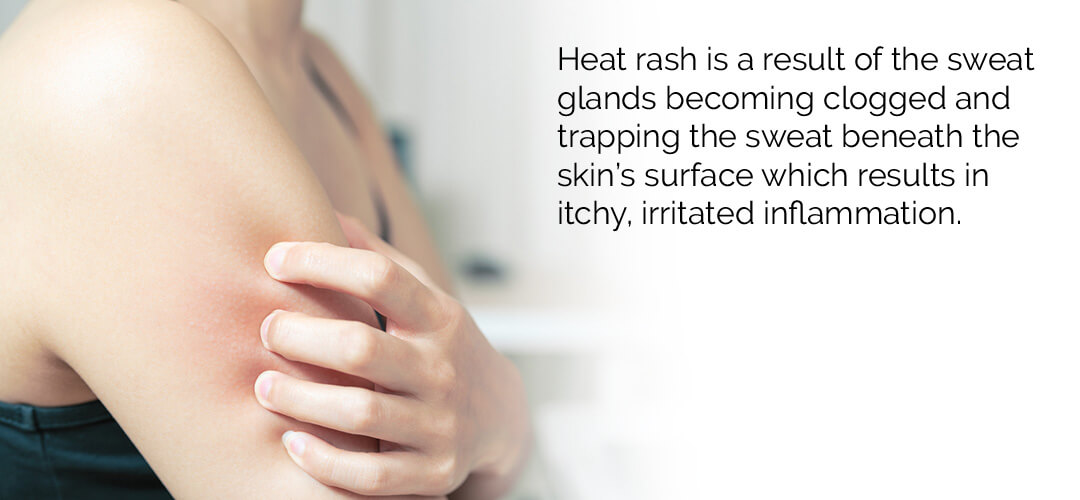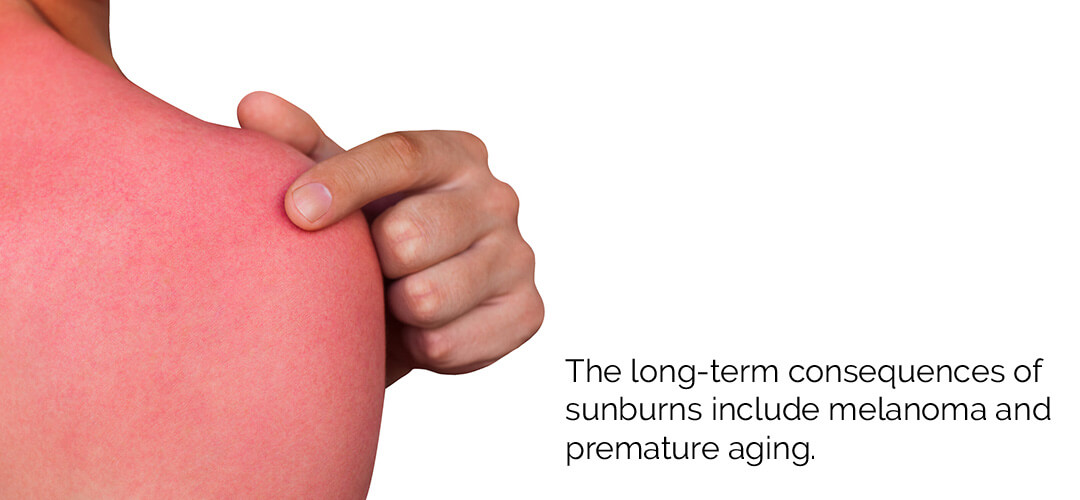We all love laying out by the pool on a warm summer day or spending the afternoon in the park for a family BBQ. But being out in the heat for too long can have adverse effects on our skin! I am not encouraging anyone to spend their summers sitting in an air-conditioned room, however, there are things you should be mindful of before spending an afternoon outdoors.
Heat Rash

A little biology 101 lesson here: our skin plays a big role in regulating the body’s temperature. It does so by sweating (or perspiring) in order to cool itself. Sweat is created in the (surprise!) sweat glands that line the entire body in the dermis and is produced when the temperature control center in our brain talks to the sweat glands and tells them we need to cool down.
But sometimes those sweat glands become clogged and the sweat cannot reach the surface of the skin. Instead, it is trapped beneath the skin’s surface which results in itchy, irritated inflammation. It also causes small, itchy bumps on the infected area. This is known as heat rash, prickly heat, or miliaria. And sweat isn’t the only thing that can clog your sweat glands. On occasion, things like dirt and dust can also cause it to clog. There have also been cases where heavy creams and lotion have been the culprit. And the clothes you wear can further irritate your skin if they cause friction or are not made from breathable fabric.
Because sweat glands line the entire body, you can get heat rash anywhere. However, it is most likely to occur in areas of the body where air circulation is difficult. This includes creases in the neck, armpit, or groin. The back of the knees and elbow crease are susceptible as well.
If you do find yourself with heat rash (which I did earlier this summer! It affected both my arms and was an itchy nightmare that lasted for about 3 to 4 days) rubbing ice or a cold compress on the affected area will help to soothe the irritation. If the irritation persists, you can go to an urgent care clinic and get a prescription for a steroid cream that will help clear the rash up. Some people recommend hydrocortisone or taking an antihistamine, but in my experience, those didn’t do much for heat rash. Heat rash can cause the tiny red bumps on your skin that are filled with puss. Itching these not only furthers the irritation but can also cause an infection if you break the skin.
Also if you have eczema, keep in mind that heat can further irritate the skin and exacerbate its symptoms.
Sunburn

By now we all know that spending too much time in the sun without sunscreen can (and usually does) result in sunburn. But too many people think that sunburn is just a minor, painful inconvenience that lasts a couple of days and then fades into a “nice tan.” But that temporary pain can have long term consequences. These include melanoma and premature aging such as crepey skin and wrinkles.
On a microscopic level, “critical” amounts of sun exposure (typically UVA radiation) result in DNA damage as UV radiation excites DNA, triggering your body’s defense mechanisms against free radicals that can cause signs of aging and cancer. Antioxidants will try to repair DNA and your body will increase melanin production to prevent future damage (Medical News Today).
What is visible at the time you burn is the damage that is done by UVB radiation (think of UVA for “aging” and UVB for “burning”), which causes painful and warm erythema (redness) that peaks within 12-24 hours, although the burn could continue to develop for up to 72 hours. After a day of prolonged exposure, you’re likely to notice tender, red skin, and potentially even blisters. If it’s particularly bad, you may experience sun poisoning, which results in fever, chills, nausea, a rash, and potentially even hospitalization (Medline Plus). Heat exhaustion and heat stroke can also be the result of particularly bad sunburn.
Obviously, the best way to prevent sunburn is by using sunscreen religiously. Apply it 30 minutes before you go outside and reapply every 2 hours. Avoid sun exposure during peak hours (11am-3pm), but if you can’t, wear a wide-brim hat and loose-fitting clothes made from breathable fabric to cover your exposed skin.
And if you do manage to get burned, there are steps you can take to help relieve it. Start by taking aspirin as soon as you start feeling or noticing the burn. According to Dr. James Spencer, a St. Petersburg, Florida dermatologist in this month’s Allure, “Ultraviolet radiation causes inflammation, and aspirin is an anti-inflammatory [that doesn’t cause thinning of the skin over time.] ” Less inflammation means less pain! After that, take a shower in lukewarm or cool water as hot showers can cause further irritation for a sunburn. Following your shower, be sure to apply aloe vera.
Bottom Line
As much as we all love summer, heat is not kind to your skin. It can cause all kinds of complications like heat rash and sunburn which can cause permanent damage to the skin. Always be mindful of how much time you are spending outside in the sun and take precautions to keep you and your skin protected!

